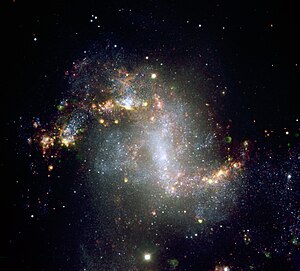astro.wikisort.org - Galaxy
NGC 1313 (also known as the Topsy Turvy Galaxy[2]) is a field galaxy[3] and a barred spiral galaxy[4] discovered by the Scottish astronomer James Dunlop on 27 September 1826.[5] It has a diameter of about 50,000 light-years, or about half the size of the Milky Way.[6]
| NGC 1313 | |
|---|---|
 A Very Large Telescope (VLT) image of NGC 1313. Credit: ESO. | |
| Observation data (J2000.0 epoch) | |
| Constellation | Reticulum |
| Right ascension | 03h 18m 15.4s [1] |
| Declination | −66° 29′ 50″ [1] |
| Redshift | 0.001568 [1] |
| Distance | 12.886 Mly[1] |
| Characteristics | |
| Type | SB(s)d[1] |
| Apparent size (V) | 9.1 x 7.1 arcmin[1] |
| Other designations | |
| Topsy Turvy Galaxy, PGC 12286, ESO 082- G 011 | |
NGC 1313 lies within the Virgo Supercluster.[7]
In 2007, a rare WO star was discovered in NGC 1313,[8] currently known by its only designation of [HC2007] 31. It is of spectral type WO3.[8] The derived absolute magnitude is about -5,[8] which is very high for a single WO star. (WOs usually have absolute magnitudes of about -1 to -4) This means that the WO is likely part of a binary or a small stellar association.[8]
Features
NGC 1313 has a strikingly uneven shape and its axis of rotation is not exactly in its centre.[9] NGC 1313 also shows strong starburst activity[10] and associated supershells.[11] NGC 1313 is dominated by scattered patches of intense star formation, which gives the galaxy a rather ragged appearance.[12] The uneven shape, the ragged appearance and the strong starburst can all be explained by a galactic collision in the past.[13] However, NGC 1313 seems to be an isolated galaxy and has no direct neighbours. Therefore, it is not clear whether it has swallowed a small companion in its past.[2]
Young, blue stars are scattered across the galaxy.[14] This is evidence of infant mortality in which the young open clusters quickly became gravitationally "unglued", scattering their resident stars into the galaxy.[15] The galaxy bears some resemblance to the Magellanic Clouds[16] and hosts two ultraluminous X-ray sources, called NGC 1313 X-1 and X-2.[17] The former is a rare intermediate-mass black hole.[18][19]
References
- "NASA/IPAC Extragalactic Database". Results for NGC 1313. Retrieved 8 Dec 2008.
- "The Topsy-Turvy Galaxy NGC 1313". ESO. 23 November 2006.
- "Taking a narrow view of lopsided galaxy". Gemini Observatory. 21 May 2010. Archived from the original on 12 June 2015. Retrieved 22 February 2016.
- Nemiroff, R.; Bonnell, J., eds. (7 August 2009). "The Star Clusters of NGC 1313". Astronomy Picture of the Day. NASA.
- Courtney Seligman. "NGC 1313 (= PGC 12286)". Celestial Atlas. Archived from the original on 2015-06-12. Retrieved 2016-02-22.
- Nemiroff, R.; Bonnell, J., eds. (30 March 2010). "Unusual Starburst Galaxy NGC 1313". Astronomy Picture of the Day. NASA.
- "Nearby Groups of Galaxies". ned.ipac.caltech.edu. Retrieved 2018-05-07.
- Hadfield, L. J.; Crowther, P. A. (2007-10-01). "A survey of the Wolf-Rayet population of the barred, spiral galaxy NGC 1313". Monthly Notices of the Royal Astronomical Society. 381: 418–432. doi:10.1111/j.1365-2966.2007.12284.x. ISSN 0035-8711.
- Materne, J. (April 1979). "The structure of nearby groups of galaxies - Quantitative membership probabilities". Astronomy and Astrophysics. 74 (2): 235–243. Bibcode:1979A&A....74..235M.
- "VLT Image of Starburst Galaxy NGC 1313". European Southern Observatory. 23 November 2006. Retrieved 22 February 2016.
- Suzuki; et al. (2013). "AKARI view of star formation in NGC 1313". Astronomy & Astrophysics. 554: A8. Bibcode:2013A&A...554A...8S. doi:10.1051/0004-6361/201220294.
- "NGC 1313". Astrosurf. 22 October 2006.
- "Tumult in NGC 1313" (in German). Wissenschaft.de. 28 November 2006.
- "Hubble Sees Star Cluster "Infant Mortality"". NASA. 10 January 2007. Retrieved 23 February 2016.
- Anne Pellerin; Martin Meyer; Jason Harris; Daniela Calzetti (2007). "Stellar Clusters in NGC 1313: Evidence of Infant Mortality". The Astrophysical Journal. 653 (2): L87–L90. arXiv:astro-ph/0702547. Bibcode:2007ApJ...658L..87P. doi:10.1086/515437. S2CID 5537525.
- Mollá, Mercedes; Roy, Jean-René (1 April 1999). "Modeling the Radial Abundance Distribution of the Transition Galaxy NGC 1313". The Astrophysical Journal. 514 (2): 781–786. arXiv:astro-ph/9903129. Bibcode:1999ApJ...514..781M. doi:10.1086/306982. S2CID 18874798.
- Matteo Bachetti; et al. (2013). "The Ultraluminous X-Ray Sources NGC 1313 X-1 and X-2: A Broadband Study with NuSTAR and XMM-Newton". The Astrophysical Journal. 778 (2): 163. arXiv:1310.0745. Bibcode:2013ApJ...778..163B. doi:10.1088/0004-637X/778/2/163. S2CID 28161179.
- Dheeraj Pasham; et al. (2015). "Evidence for High-Frequency QPOs with a 3:2 Frequency Ratio from a 5000 Solar Mass Black Hole". The Astrophysical Journal. 811 (1): L11. arXiv:1601.02628. Bibcode:2015ApJ...811L..11P. doi:10.1088/2041-8205/811/1/L11. S2CID 33907571.
- "Intermediate-Mass Black Hole 5,000 Times Mass of Sun". Sci-News.com. 23 September 2015. Retrieved 23 February 2016.
External links
 Media related to NGC 1313 at Wikimedia Commons
Media related to NGC 1313 at Wikimedia Commons
На других языках
[de] NGC 1313
NGC 1313 ist eine Balkenspiralgalaxie vom Hubble-Typ SB(s)d im Sternbild Netz am Südsternhimmel. Sie ist schätzungsweise 14 Millionen Lichtjahre von der Milchstraße entfernt, hat einen Durchmesser von etwa 50.000 Lj und als sogenannte Starburstgalaxie klassifiziert. Auffallend ist die ungleichmäßige Form der Spiralarme, deren Rotationsachse zudem nicht genau im Zentrum liegt.[3] 16 Bogenminuten südöstlich von NGC 1313 befindet sich eine weitere Balkenspiralgalaxie (vom Hubble-Typ SBb), welche als NGC 1313A (= PGC 12457, ESO 83-1) bezeichnet wird. In NGC 1313 wurden bisher zwei Supernovae gesichtet, nämlich SN 1962M (Typ II-P) und SN 1987K (Typ IIb).- [en] NGC 1313
[es] NGC 1313
NGC 1313 es una galaxia espiral barrada localizada en la constelación de Reticulum.[ru] NGC 1313
NGC 1313 (другие обозначения — ESO 82-11, VV 436, AM 0317-664, IRAS03176-6640, PGC 12286) — спиральная галактика с перемычкой в созвездии Сетка. Этот объект входит в число перечисленных в оригинальной редакции «Нового общего каталога».Другой контент может иметь иную лицензию. Перед использованием материалов сайта WikiSort.org внимательно изучите правила лицензирования конкретных элементов наполнения сайта.
WikiSort.org - проект по пересортировке и дополнению контента Википедии